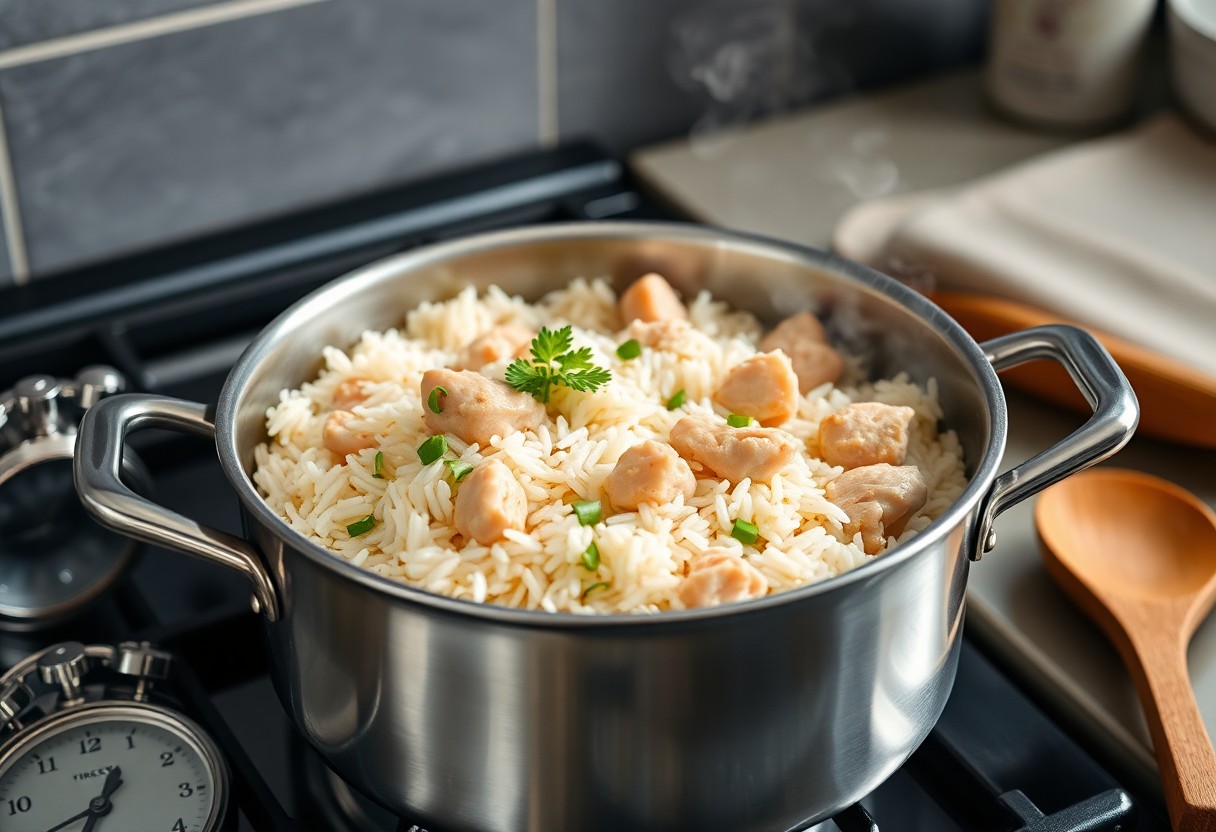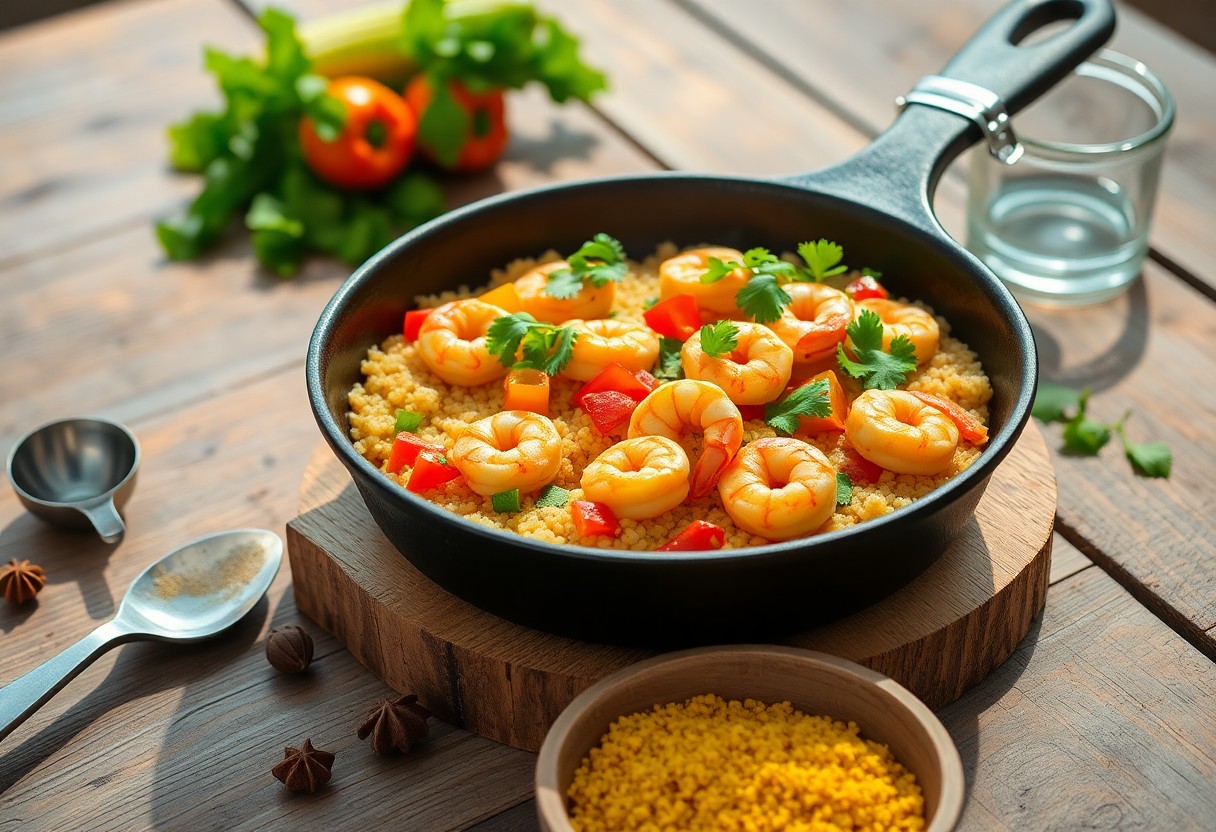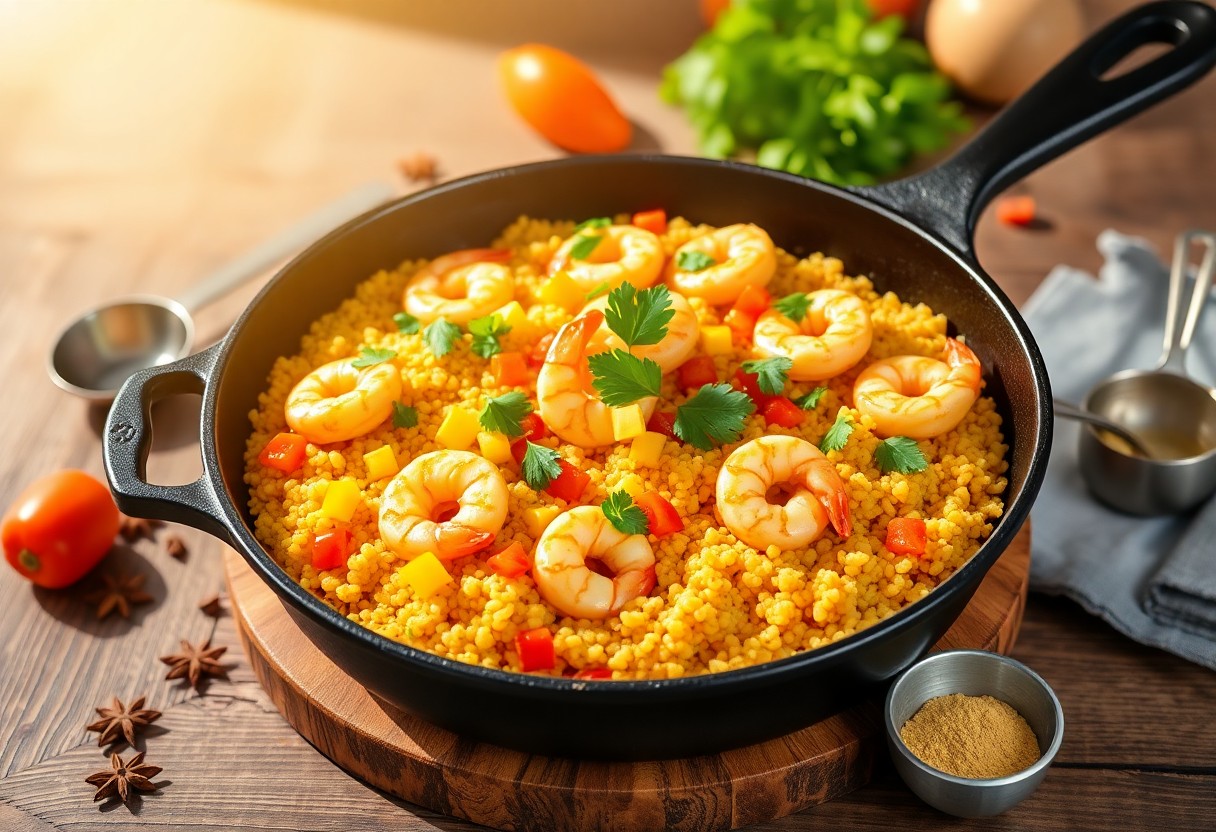Cooking rice alongside your choice of protein can be a delicious and efficient way to prepare a balanced meal, but it’s important to get the timing just right to avoid overcooking. By following precise water measurements and cooking times, you can achieve perfectly tender rice and protein that complements each other beautifully. This method not only saves you time but also minimizes cleanup, allowing you to enjoy a wholesome dish without the hassle. Let’s explore the simple steps that will turn your one-pot meal into a culinary success!
Key Takeaways:
- Choose the right type of rice: Opt for rice that has similar cooking times to the protein you’re using, such as chicken or fish, to ensure even cooking.
- Adjust liquid proportions: Ensure that the amount of liquid used is adequate for both the rice and protein, as this will help achieve the desired consistency without overcooking.
- Control cooking time: Monitor the cooking time closely, adding the protein at the right moment to ensure both the rice and protein finish cooking simultaneously.
Mastering the Rice-to-Water Ratio
The rice-to-water ratio is vital for achieving perfectly cooked rice and protein together. Generally, a ratio of 1:1.5 works for most types of white rice, while brown rice requires closer to 1:2. Adjusting the quantity of water based on your desired texture can make all the difference in your dish. By understanding these measurements, you’ll ensure your rice remains fluffy and your protein is tender, leading to an irresistibly delicious meal.
Determining the Perfect Ratio for Different Rice Varieties
Each variety of rice has its own unique water requirements. For instance, basmati rice typically uses a 1:1.5 ratio, while jasmine rice thrives on a 1:1.75 ratio. Short grain rice may need more moisture, approximately 1:2. Understanding these specifics allows you to tailor the cooking process based on your recipe and preference, ensuring fluffy grains without overcooking.
Factors That Influence Cooking Time and Texture
Various elements can affect how your rice and protein cook together, including grain size, thickness of your protein, and even your pot’s material. Smaller grains like sushi rice tend to cook faster than larger varieties, while bone-in chicken will require a longer cooking time than tender fish fillets. Remember to account for how the protein releases moisture, which can impact the overall cook. This balance between cooking times will influence the final texture of your entire dish.
- Grain size significantly affects cooking duration.
- Protein thickness directly impacts moisture levels.
- Pot material can alter heat distribution.
- Cooking time varies based on external factors.
- This understanding allows you to modify cooking methods appropriately.
In addition to what’s mentioned, the type of heat source and the lid you use can greatly influence the cooking performance. High heat might lead to quick evaporation, while low heat can result in undercooking. Opting for a tight-fitting lid helps retain steam, ensuring even cooking. This attention to detail will enhance the outcome of both your rice and protein dishes.
- Heat source type can change how evenly your food cooks.
- Lid quality affects steam retention, crucial for even cooking.
- Cooking environment contributes to moisture management.
- This awareness promotes a seamless cooking experience.
Protein Pairing: Choosing the Right Ingredients
Selecting the appropriate proteins is key to a successful one-pot meal. Your choice should not only complement the flavors of the rice but also align with the cooking time and methods for optimal results. Factors such as tenderness and seasoning of your protein will greatly influence the dish’s outcome. You can create a balanced meal by harmonizing contrasting ingredients, while also taking note of the different moisture levels they may bring to the pot.
Best Protein Options for One-Pot Cooking
For one-pot dishes, consider proteins like chicken, tofu, and shrimp. These options cook relatively quickly and absorb flavors well, ensuring a delicious outcome. Ground meats and fish fillets are also effective for speedy meals. Alternatively, legumes such as beans and lentils can be great plant-based options that add protein and nutrients to your dish, making them particularly versatile and healthy.
How Protein Types Affect Cooking Time and Temperature
Cooking time varies significantly across different protein types. For instance, chicken remains tender at around 165°F, needing approximately 25-30 minutes to cook through, while tofu can be added directly to the pot and heated in 10-15 minutes. Firm or fatty fish like salmon typically finishes cooking in about 15-20 minutes. Cooking legumes may require pre-soaking or longer simmering times but yield hearty, nutritious results that fit well with rice.
| Protein Type | Cooking Time (Minutes) |
|---|---|
| Chicken (boneless) | 25-30 |
| Tofu | 10-15 |
| Shrimp | 5-7 |
| Fish (salmon) | 15-20 |
| Legumes | 30-60* |
As you’ve seen, each protein type influences your cooking process in distinct ways. Chicken demands a slightly longer cooking duration to reach a safe internal temperature, while tofu’s flexibility allows for quick incorporation. Understanding the variability in performance helps streamline your preparation, making it easier to achieve perfectly cooked protein and rice together. When learning about these differences, you’ll enable your meals to develop robust flavors and textures more naturally.
- Protein Types: chicken, tofu, shrimp, legumes, fish.
| Protein Type | Impact on Temperature |
|---|---|
| Chicken | 165°F |
| Tofu | 150°F |
| Shrimp | 120°F |
| Fish | 145°F |
| Legumes | 190°F* |
- Cooking Temperature: crucial for protein safety and texture.
Perceiving the relationship between protein types and cooking times allows you to avoid overcooking or undercooking, ultimately enhancing your culinary skills in one-pot cooking. Failure to understand this could lead to less-than-desirable results in texture and flavor.

The Art of Timing: When to Add Each Component
Getting the timing right is vital for all components to cook perfectly. Start by considering the cooking times of your rice and protein. For instance, if you’re using a quick-cooking protein like shrimp or chicken breast, add it just 10-15 minutes into the rice cooking process. Hefty proteins like beef or lentils may require a longer pre-cook time, so anticipate those needs to avoid overcooking your rice while achieving tender meat.
Timing Strategies for Simultaneous Cooking
Utilizing precise timing strategies can simplify one-pot meals. Begin with the rice, adding enough liquid based on its cooking time. Once you reach the halfway mark of the rice’s cooking time, incorporate your protein. This method allows for both rice and protein to finish simultaneously, optimizing flavor and texture.
Techniques for Adjusting Cooking Time for Even Results
The key to even cooking lies in recognizing the varying textures and densities of different proteins. To compensate for these differences, consider cutting your protein into smaller, uniform pieces. This not only speeds up their cooking time but also ensures they achieve tenderness by the time the rice is ready. Stirring occasionally is another technique that can prevent uneven cooking.
For proteins that require slightly longer cooking times, use a method called “staggered cooking.” So, if you’re cooking brown rice that typically takes 40 minutes, start cooking it first and add the protein around the 20-minute mark. Conversely, when using proteins with shorter cooking times, ensure to add additional liquid earlier on to maintain moisture. This adaptable approach allows you to create a seamless integration of textures while avoiding overcooking the rice. Paying attention to visual cues—like the color of the protein and texture of the rice—will guide you toward achieving a perfectly balanced dish.

Flavor Infusion: Enhancing the Dish with Aromatics and Seasonings
To elevate your one-pot meal, integrating aromatic ingredients and seasonings can work wonders. Incorporate elements like garlic, onions, ginger, or fresh herbs to create a fragrant base that permeates the rice and protein. Adding spices such as cumin, coriander, or paprika early in the cooking process allows their flavors to bloom, resulting in a vibrant dish filled with depth and character.
Choosing Seasonings That Complement Both Rice and Protein
Selecting the right seasonings can harmonize your dish remarkably. Opt for neutral spices like thyme or oregano, which pair well with various proteins and grains. If you’re using chicken or fish, lemon zest or dill can brighten the dish, while going for bold seasonings like curry powder can beautifully accentuate dishes featuring chickpeas or lentils. Always consider the primary flavor profile of your protein when making seasoning choices.
Layering Flavors for Maximum Impact
Flavor layering involves adding different ingredients at various stages of cooking to build complexity. Start with aromatic ingredients at the base, followed by spices, and incorporate any acidic components like lime or vinegar towards the end. This technique not only enhances the overall flavor profile but ensures that each ingredient contributes its unique taste effectively without overpowering others.
For instance, sautéing onions and garlic in oil before adding your rice can lay a savory foundation. As your dish simmers, introduce spices that bloom in the heat, creating rich undertones. If using tomatoes or broth, incorporate them early for thorough infusion, while fresh herbs can be mixed in just before serving to maintain their vibrant flavor. Each layer you add builds the dish into a cohesive, flavorful experience, ensuring no ingredient feels isolated.
Troubleshooting Common Overcooking Pitfalls
Even with the best intentions and practices, mistakes can happen. Knowing how to troubleshoot common overcooking pitfalls enables you to salvage your meals. Overcooked rice and protein can arise from incorrect ratios, improper timing, or choosing the wrong cooking method. By being aware of these factors, you can fix missteps before they become unsalvageable and ensure your dish maintains its intended flavor and texture.
Recognizing Signs of Overcooked Rice or Protein
Identifying overcooked rice or protein is straightforward. For rice, look for grains that are mushy, sticky, or clumped together, with a noticeably soft texture. Similarly, protein, whether chicken, beef, or tofu, can be recognized by its dry, tough exterior and lack of moistness. A quick taste test will reveal if a specific ingredient has lost its intended flavor and consistency.
Solutions for Common Mistakes in One-Pot Cooking
Adjusting your approach can solve many common cooking mistakes. If rice becomes too soft, reduce your next batch’s cooking time by a couple of minutes or cut down on liquid ratios. For overcooked protein, consider removing it earlier next time or decreasing the heat on your stove to allow for gentler cooking. Monitoring your dish closely and making adjustments based on observations can lead to consistently better results.
One practical solution to prevent these issues is using a timer for both rice and protein. For instance, add rice to the pot first, cook it according to the package instructions, then add protein halfway through that cooking time. If using a slow cooker, reducing the temperature can provide a gentler cooking environment, especially for proteins that can easily become tough. Repeating this process allows you to hone in on the ideal timing for each component based on your chosen ingredients and personal preference, steadily improving your one-pot cooking skills.
Summing up
To wrap up, cooking rice and protein in the same pot requires a clear understanding of cooking times and liquid ratios. Begin by selecting proteins that cook at similar times to your rice, such as chicken or shrimp, and consider marinating them for added flavor. Rinse your rice thoroughly to prevent stickiness, then layer it in the pot with the protein and the appropriate amount of liquid based on your rice type. By adjusting heat and cooking time carefully, you can achieve perfectly tender rice and protein, all in one convenient pot, simplifying your meal preparation.
FAQ
Q: What is the best method to cook rice and protein together without overcooking the rice?
A: The best method to cook rice and protein together is to utilize a layered approach. Start by rinsing the rice thoroughly to remove excess starch, which can contribute to stickiness. Use a pot with a tight-fitting lid and add the appropriate amount of water for the rice (typically 1:2 ratio of rice to water) along with the protein. Cook the rice and protein on medium heat until they reach a gentle boil. Once boiling, reduce the heat to low, cover the pot, and let it simmer. The protein, such as chicken or fish, should be cut into small, uniform pieces to ensure even cooking. This method helps maintain the texture of the rice while allowing the protein to cook through effectively.
Q: How can I ensure the rice cooks perfectly while the protein is still tender?
A: To ensure the rice cooks perfectly while the protein remains tender, timing is necessary. Start cooking the rice for about 10-15 minutes before adding your protein. This allows the rice to begin softening before adding the protein, which requires a shorter cooking time. If using quick-cooking proteins like shrimp or small pieces of chicken, you can add them to the pot once the rice is about halfway cooked. Be sure to monitor the cooking times of both the rice and the protein, adjusting the heat as needed to prevent overcooking. Additionally, you can add a splash of broth or seasoning at the beginning, which will infuse flavor into both the rice and protein.
Q: Are there any specific types of rice and proteins that work best for this cooking method?
A: Yes, certain types of rice and proteins pair better for this cooking method. Long-grain rice varieties, such as Basmati or Jasmine, are ideal because they tend to remain fluffy and separate when cooked. For proteins, lean meats such as chicken breast, fish, or tofu are great choices since they cook quickly and won’t overpower the rice. It’s also advisable to use proteins that can benefit from quick cooking times and flavor absorption, like shrimp or thinly sliced beef. For added flavor, consider marinating the protein beforehand, as it enhances the overall taste of the dish. Be mindful of the cooking times to achieve the best texture for both components.
